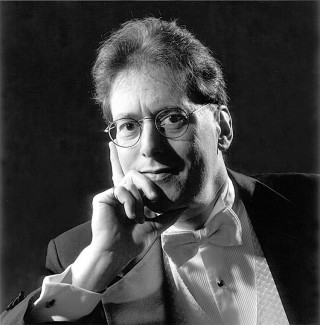Title

Robert Levin
(Photo by Herb Ascherman)On Valentine's Day, Gary Thor Wedow will conduct the Juilliard Orchestra, Juilliard singers, and the Westminster Schola Cantorum and Chapel Choir in an all-Mozart program. The concert will close with visiting faculty member Robert Levin's completion of the Mozart Requiem; he recently spoke with The Journal about how he came to be one of a long line of musicians to tackle finishing this titanic piece, which Mozart was working on when he died.
Body
It all began, rather improbably, with the idea of improvising cadenzas for a Mozart piano concerto.
During the summer of 1966, Harvard student Robert Levin was in Europe, studying with the legendary conducting teacher Hans Swarowsky, who told him, “Anyone who wants to play Mozart piano concertos has to improvise.” At the time the very notion of improvising Mozart was heretical and Levin, who had been taught you play what's on the page, period, questioned Swarowsky. “He told me to get a recording of a live concert he conducted with Friedrich Gulda playing a Mozart concerto and improvising,” Levin told The Journal, so he found the recording “and thought to myself, ‘I need to do this, but how?'”
The Vietnam War was raging, which meant he couldn't follow his first impulse and take a leave of absence from school to go study with Gulda—that would have meant he would have been drafted—so he had no alternative but to teach himself, which he did, using the tools he'd learned from studying with Nadia Boulanger in Paris a few years before.
Later in the school year, Levin was asked to play the organ for a local performance of the Mozart Requiem. The conductor had the latest edition of the score, which included some recently discovered fragments including the beginning of a fugue on the subject of Amen that was probably meant to end the Lacrimosa. “Why don't you finish that fugue and we'll perform it as part of the Requiem?” the conductor suggested.
“I told him there were a lot easier ways to make a complete fool of yourself,” Levin remembers. But he thought about it and decided it wouldn't be the same as taking a box of paints and finishing an incomplete Rembrandt painting. “Working with music, the historical artifact is left untouched and unscathed,” he said. “Completing the Amen fugue changes nothing except how a particular performance will sound at the moment.” Besides, he reasoned, if he was going to improvise a cadenza of a piano concerto during a performance, a good way to start could be to learn how to compose in the style of Mozart.
That positive experience led Levin to switch his major from French to music and write his senior honors thesis on Mozart's unfinished works. A concert at which a couple of his newly completed Mozart works were played led to musicians—some of them principal players in the Boston Symphony—asking him to complete works for their instruments, and he soon developed a specialty in the area.
As time went on Levin toyed with finishing the Requiem but kept putting it aside—until 1987, when in a scholarly talk about the Requiem, he evaluated the various completions of the work from the linguistic and structural perspective and described how he'd completed the Amen fugue as an undergrad. He explained that, unlike some other completions of the fugue, he felt it should not modulate into other keys. After all, the purpose of the Amen is to conclude. Then he sat down at the piano and played his completion of the fugue—after which the audience burst into applause.
A couple of weeks later, Helmuth Rilling, the conductor who'd invited Levin to give the paper, called and told him he'd been struck by Levin's deft analysis on the problems with the completions of the Requiem and decided to commission Levin to complete it in time for the 1991 Mozart Bicentennial.
Levin, flabbergasted and deeply honored, listed the enormous limitations that would preclude him from accepting such a task. “For one thing, I have the wrong nationality,” he told Rilling. “It's one thing for me to complete an oboe concerto or a clarinet quintet. But the Mozart Requiem isn't just an unfinished piece of music, it's an iconic work in Western civilization. And last, but certainly not least, I have the wrong surname. It could conceivably subject you, and me, to a good deal of ugliness.”
But Rilling had faith in Levin—and wouldn't take no for an answer until, Levin recalled, “finally I thought, ‘It's got to be easier to complete the Requiem than it is to go on arguing.'” So he accepted and worked on the piece piecemeal, sending parts to be tried out.
Over the years, many have completed the Requiem, starting within days after Mozart's death, in 1791 (his family needed the money). One difference from many of them was that Levin didn't jettison everything that was not known to be composed by Mozart. “I was very careful to minimize what I did. I tried to simplify, to clean up the somewhat thick orchestral textures, for instance, so the choral lines and the solo lines of Mozart were thrown into stronger relief,” he said.
Levin's version was scheduled to be premiered in August 1991, in Stuttgart. “At every rehearsal I changed things, and Rilling was perfectly fine with that,” Levin said. “He was never fazed, never told me to quit. Half an hour before the world premiere I was still making changes.” A very Mozartean thing to do. The audience loved it—and Rilling recorded it and conducted it all over the world.
“People ask if I'd change things,” Levin said, “and I say, of course, I'd tinker with it here and there. But then the more I think about it, I see why I did what I did.”




